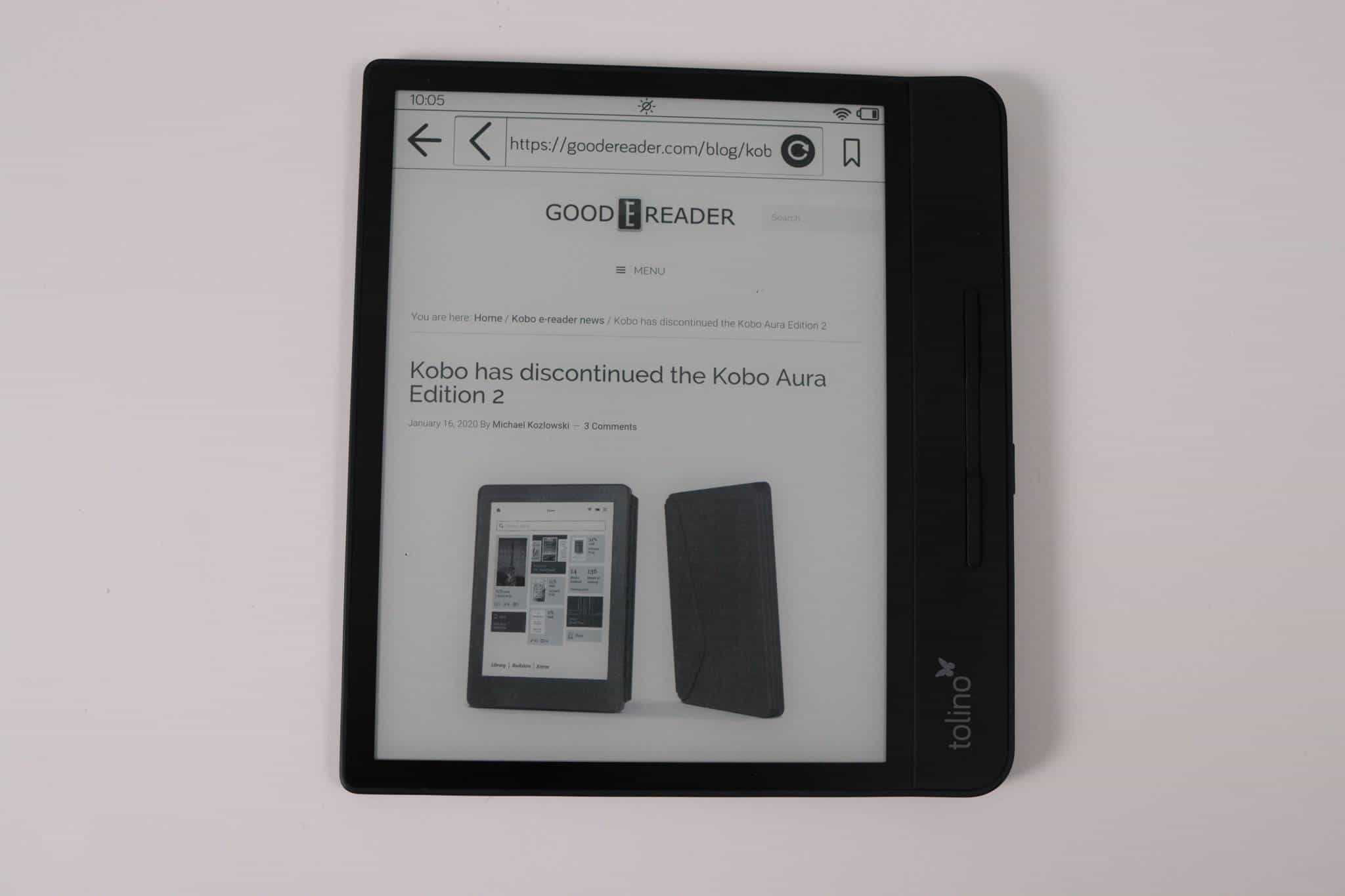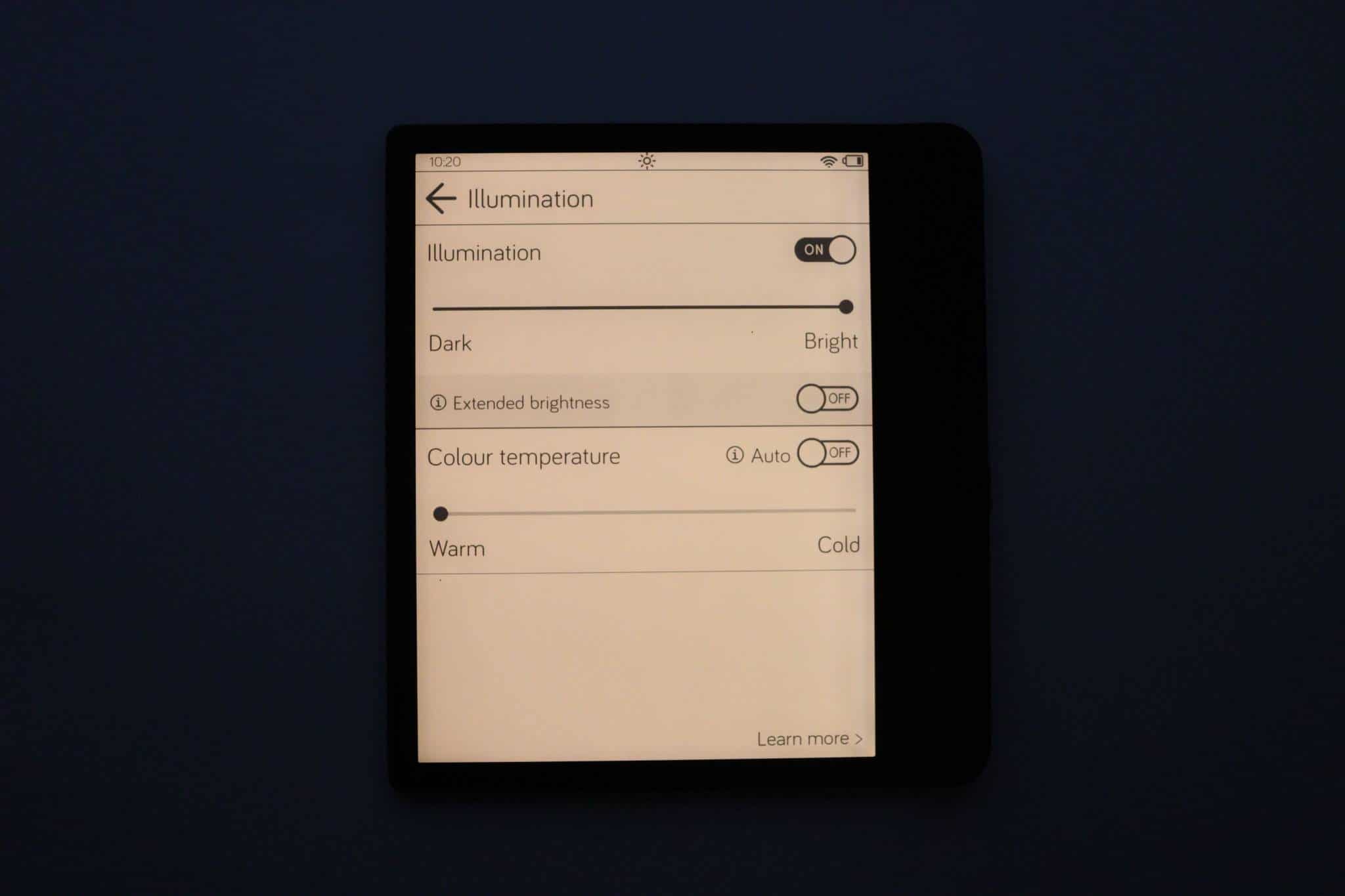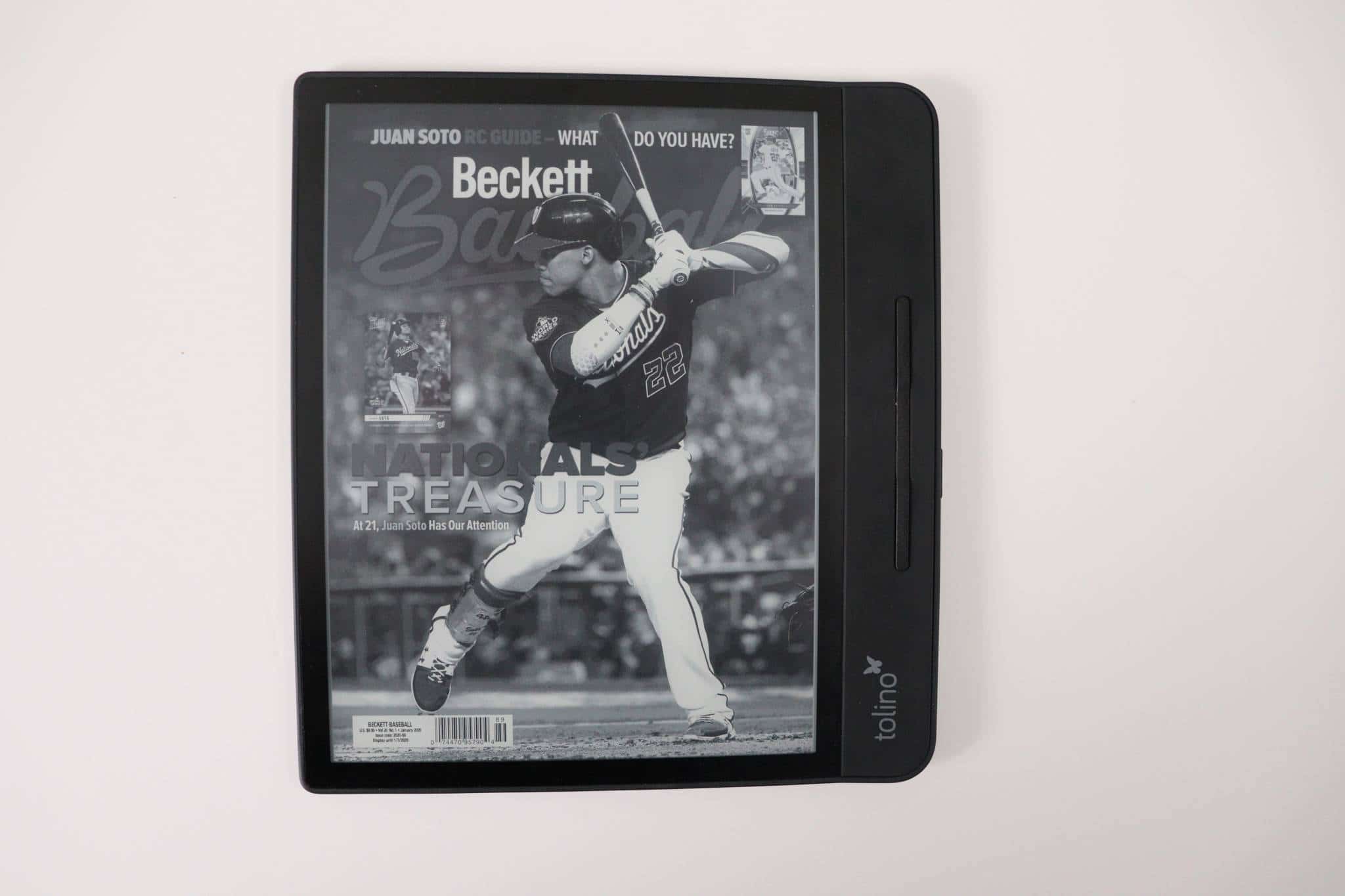
The Tolino Epos 2 is the most expensive and largest e-reader from Tolino and this device is geared towards a German speaking audience in countries such as Austria, Belgium, Germany, Netherlands, Switzerland and France. You can establish what bookstores you want to do business with, and there are at least two different ones per country. This device also plays nice for people who want to sideload their own digital content.
Hardware

The Epos 2 features a 8 inch capacitive touchscreen display that utilizes E INK Carta HD and a Mobius display with HD resolution 1440 x 1920 and 300 PPI. The Mobius pane really makes this ereader light and somewhat flexible, so you do not have to worry about breaking it, if it is accidently dropped.
This product is designed to read in the dark and has a front-lit display and color temperature system. There are 17 white and amber LED lights for even light distribution across the screen. The lighting system has a small light symbol in the top center, that is used to turn it on or off. On the top right-hand side there is another light symbol and this is used to configure advanced settings. There are two slider bars, one is for the white LED lights and the other is to adjust the color temperature, or amber LED lights. You can mix the two together to provide an optimal viewing experience, so your screen will never be bright white or completely orange.

There are a few new features for the lighting system, extended brightness and auto color temperature. Extended Brightness will increase the brightness of the screen beyond the normal levels, but it will sacrifice battery life. You need to crank the light to the max, and it will actually make the screen around 40% brighter, tremendously useful and no other e-reader has this feature. Automatic color temperature will change the amber LED lights on the e-reader based on the time of day, which is basically using your e-readers timezone and clock. Make sure you adjust the time zone in the settings menu, so this lighting system will be optimal. I wish they actually used a ambient light sensor, considering this device costs $299 Euros.
The Epos 2 screen is completely flush with the beszel and the power button is on the side, right beside the USB port. This was as an industrial design decision because it uses a water-repellent IPX8 coating, which protects it for up to 60 minutes in up to 2 m of fresh water. You can use the Epos 2 at the beach or in the bathtub, or even dump coffee on it, and it will be fine, once you try it off.
There are two manual page turn buttons on the left side. These are used if you do not want to tap and make gestures on the touchscreen. This device does not have a gyroscope, so you cannot flip the orientation around to view ebooks on landscape mode or switch up the buttons so left-hand users can employ it. There is a left hand feature in the settings menu, which basically moves the back and forward button form the right side of the screen to the left. This is kind of a haphazard design, I wish Kobo would have made a setting option to switch the orientation so lefthanded readers could click on the buttons. Speaking of the buttons, you can invert the buttons, so the top one can be set to turn a page backward, instead of forward, which is useful for manga. The buttons can also be mapped for specific functions, so instead of page turns, they can access the lighting system or the settings menu.
Underneath the hood is a Freescale/NXP IMX6 Solo Lite 1 GHZ processor and 512MB of RAM. There is only one storage option available to purchase, which is the 8GB model. After the OS and all of the software has been installed at the factory, there is around 5.8GB available when you take it out of the box. 25 GB additional online storage is available in Germany, Austria and Switzerland. The dimensions are 159 x 177,5 x 3,9 mm and weighs 195 g.
On a pure hardware level, the EPOS 2 is basically a clone of the Kobo Forma. It is using all of the same specs, except for the software experience. Kobo uses Linux for their own line of e-readers, whereas Tolino employs Android. That is the main difference between these two products. I found the Tolino version will actually appeal towards newer users, because it lacks all of the advanced features.
Software

The Tolino Epos 2 is employing a heavily skinned version of Android. You would never know it is running Android, unless you look deep into the settings menu and look at the licensing agreement.
The home screen of the Epos 2 makes good use of the eight inches. On the top left hand corner is the settings menu and at the very top-center, lurks a light symbol to turn on or off the light system. On the top right is the advanced lightning options, a search feature and above that is the WIFI symbol and remaining battery life.
There is large ebook cover art of the books you have recently added to the e-reader, whether you have purchased them from an online store such as Thalia, or have sideloaded. There is enough room on the screen for three different ebooks or PDF files. Underneath that is a link to “my books”, which brings you to the library menu. Below that is a slideshow carousel of the bookstore you have associated with the device. The bookstore is established during the setup process, when you select what country you live in and are presented with a few different bookstores to choose from. This will always be the default store.
The settings menu is fairly simplified, you can view your bookstore account, access the web-browser, select advanced settings and view information and help. The main settings menu can change things like using your own images as the default screen saver when it is in sleep mode. You can select the number of pages, before a full-page refresh occurs, the default is never. You can also change the UI of the device and it supports English, German, Spanish, French, Italian and Dutch.

A few of the most notable settings options is the system wide dark mode, which will invert the colors. The background will be black and all of the text is white. There is also a passcode lock, where you can establish a four digit numerical code to unlock your device out of sleep mode, useful if you leave it at the office or don’t want the kids to play around with it. A word of caution though, there is no password retrieval system, so if you forget your password, nobody can reset it, not Kobo or Tolino. Best to use something you will never forget. I also really dig the system wide large text feature, so people with poor eyesight can crank up the text in all of the UI and menus. Ebooks can also be adjusted for large text.
There is one very useful touchscreen interaction you should be made aware of, and that is swiping upwards from the very bottom of the screen. This acts as a home button, it will always bring you back to the main home screen. This is very handy and sure beats hitting the back button five or six times.
The Library menu showcases all of the books you have purchased or have sideloaded. You can do things like add a bunch of titles to a new or existing collection. You can mark books as finished or delete them entirely from your e-reader. Mixing up your viewing of your library is also something that can be configured. There are options for list/grid view, show completed books, or hide them. Sorting options include last read, title or author.
The one thing I like about the Epos 2, is that it lacks most of the advanced features that Kobo employs. Selecting the web-browser, system-wide dark themes or just viewing the user manuals are never beyond 2 menu selections. There aren’t a bunch of slider bars you have to deal with, just simple, on/off type of functions.
Reading Experience

You are purchasing the EPOS 2 because you want a large screen and dedicated e-reader that has respectable battery life and has a singular purpose, to read. It only supports a few different ebook formats such as EPUB, PDF, TXT and is compatible with eBooks from public lending libraries, e.g. Onleihe.
When you open up an ebook you can tap the center of the screen and it will open up all of the reading settings. You can access the table of contents in a hyperlink format, so you can quickly jump chapters, you can even do this sideloaded books. You can view all of your bookmarks and notes you have made and adjust the reading settings.
There is a slider bar that controls the size of the text and a bunch of font-types you can choose, such as Bitter, Fira Sans, Source Sans, Droid Serif, OpenDyslexic or Vollkorn. There is even a feature to enable publishers defaults, which optimizes the book. There is also three options apiece for line spacing, alignment and margins.
If you long press on a specific word you can make a highlight, add a note, look it up in one of the eight dictionaries or translate a word from one language to another. The keyboard is a standard QWERTY layout, but the keys are not at an angle. There is a row of numbers on the top, which is useful for taking notes, but also entering WIFI passwords.

The PDF experience is terribly lacking. Large PDF files load quickly, but page turn speed is agonizingly ponderous. You can hit the forward button and it will take between 2-5 seconds for a page to turn. The speed is increased, depending on how big the file is. For the review, I loaded in a standard 150 page file that was roughly 140MB. One of the features I liked about the PDF rendering engine was being able to click on the magnifying glass to zoom in, if you turn a page, the zoom level is persistent, so you don’t have to rezoom in every page.
Wrap up

The Tolino EPOS 2 makes sense to purchase if you live in one of the supported countries where you can buy one. If you speak German and do not live in the surrounding countries, you won’t be able to purchase this e-reader, since Tolino does not really have many distribution partners. If you live in the UK, you can buy one from Amazon.co.uk, but if you live in North America, South America, Japan or Australia, you can’t purchase one.
If you speak German and live in a supported country, this device is pretty good. The Tolino brand formed roughly 8 years ago and the Tolino Alliance was made up of all of the big bookstores and tech companies to fend off Amazon. The Tolino brand is the most popular in Germany, since it can be purchased in bookstores and smartphone shops. It has tremendous retail visibility, whereas the Kindles are only available online.
This e-reader is expensive, you are looking at around $299 Euros, but it has a very large eight inch screen, plenty of options and the front-light system is tremendous.
Michael Kozlowski is the editor-in-chief at Good e-Reader and has written about audiobooks and e-readers for the past fifteen years. Newspapers and websites such as the CBC, CNET, Engadget, Huffington Post and the New York Times have picked up his articles. He Lives in Vancouver, British Columbia, Canada.
